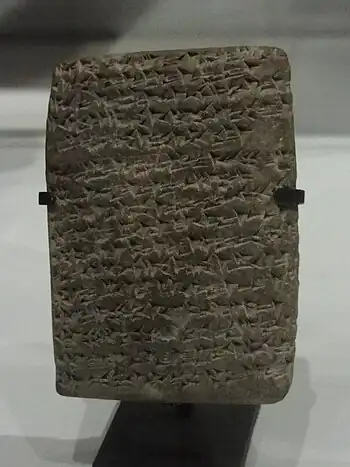Gáb
The cuneiform sign gáb, (also qáb), is an uncommon-use sign of the Amarna letters, and other cuneiform texts. It is possibly an equivalent sign for the later version of DAGAL (extensive Sumerogram), ![]() , with an,
, with an, ![]() , replacing the earlier version, the "star" (as Dingir), contained within the cuneiform sign. This later version of DAGAL is somewhat similar to gáb, (a 'rectangular-box form'). The meaning of "DAGAL", Akkadian language for "extensive" – compares to the Amarna letters use of gáb as Akkadian language "gabbu", English language for "all", or "all (of us)"[1]
, replacing the earlier version, the "star" (as Dingir), contained within the cuneiform sign. This later version of DAGAL is somewhat similar to gáb, (a 'rectangular-box form'). The meaning of "DAGAL", Akkadian language for "extensive" – compares to the Amarna letters use of gáb as Akkadian language "gabbu", English language for "all", or "all (of us)"[1]
.jpg.webp)

Cuneiform sign gáb, used twice on obverse; also qáb, twice on obverse.
(Approximate equivalent (Old Babylonian version).)
For Rainey's version of EA letters 359–379 (only 10 actual letters)[2] gáb is only used to spell Akkadian "gabbu", and 2 words using qáb, mostly for Akkadian "qabû", English "to speak", and in EA 259 (the "King of Battle, Tablet I"), for "battle", Akkadian "qablu".[3]
Cuneiform gáb/qáb is mostly used as a syllabic for the three characters of the sign. It is within a small group of signs that are composed of 1- or 2-vertical strokes (at right or left), the other signs being no. 535 Ib (cuneiform), no. 536 ku (cuneiform) (only 1-vertical, left and right), no. 537 lu (cuneiform), and no 575, ur (cuneiform).
Epic of Gilgamesh usage
The gáb/qáb sign as shown is not found in the Epic of Gilgamesh. The Epic uses kab/kap, for example, ![]() -(digitized version).
-(digitized version).
References
- Rainey, 1970. El Amarna Tablets, 359-379, Glossary:Vocabulary, gabbu, pp. 55-87, p. 63.
- Rainey, 1970. El Amarna Tablets, 359-379, Anson F. Rainey, (AOAT 8, Alter Orient Altes Testament 8, Kevelaer and Neukirchen -Vluyen), 1970, 107 pages.
- Rainey, 1970, Glossary:Vocabulary, qablu, pp. 55-87, p. 68.
- Moran, William L. 1987, 1992. The Amarna Letters. Johns Hopkins University Press, 1987, 1992. 393 pages.(softcover, ISBN 0-8018-6715-0)
- Parpola, 1971. The Standard Babylonian Epic of Gilgamesh, Parpola, Simo, Neo-Assyrian Text Corpus Project, c 1997, Tablet I thru Tablet XII, Index of Names, Sign List, and Glossary-(pp. 119–145), 165 pages.
- Rainey, 1970. El Amarna Tablets, 359-379, Anson F. Rainey, (AOAT 8, Alter Orient Altes Testament 8, Kevelaer and Neukirchen -Vluyen), 1970, 107 pages.